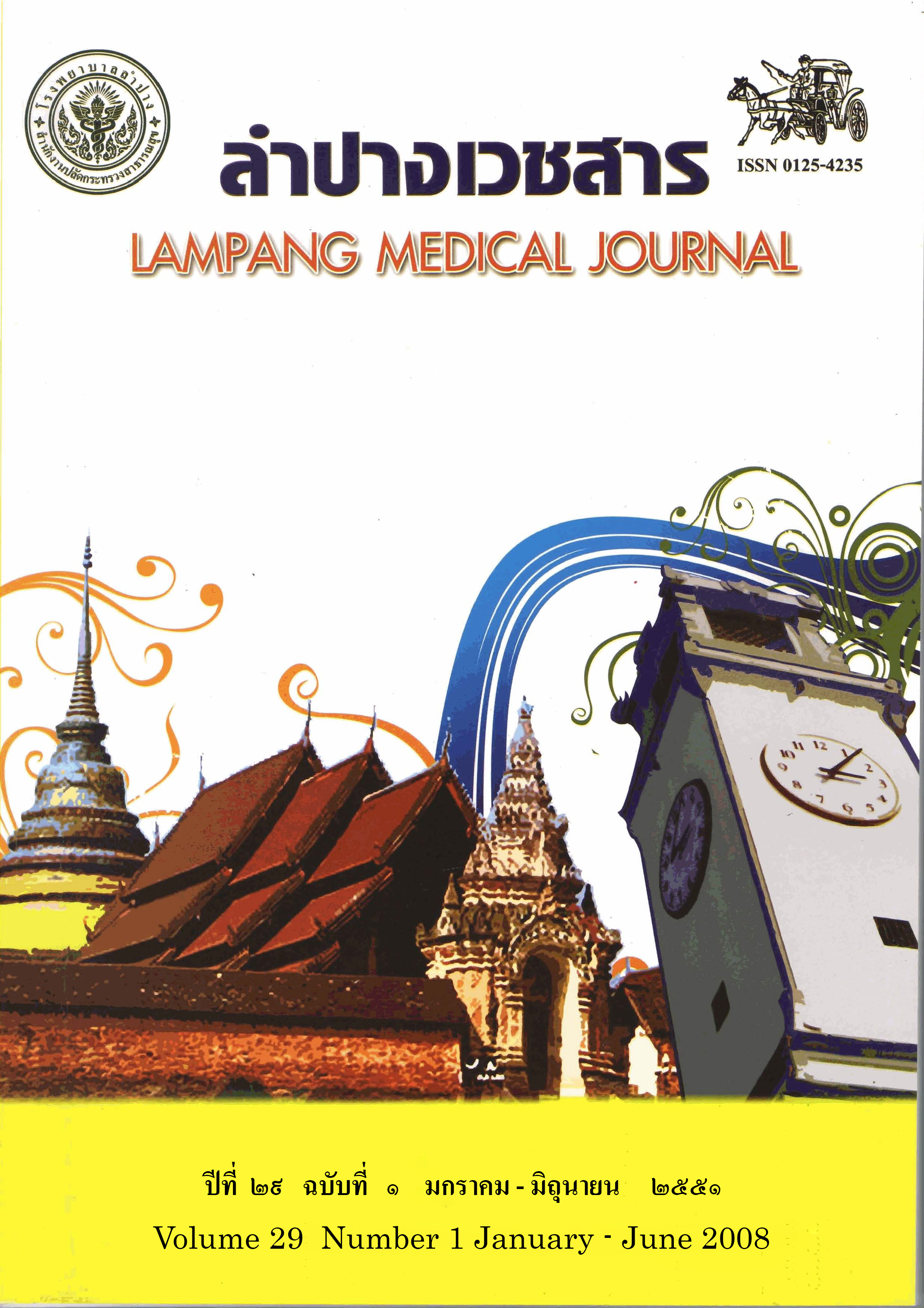Factors that influcence the major bleeding in various patients on chronic warfarin therapy
Main Article Content
Abstract
Warfarin has been used extensively as an anticoagulant for a variety of disease. The factors that influence the major bleeding
in various patients on chronic warfarin therapy were studied. A retrospective cohort study was conducted on patients who were
being seen in outpatient clinics. The record of 382 patients were reviewed. It has been founded that 54 patients had major bleeding.
Factors that influcnce the major bleeding were history of previous bleeding for 11 cases (IRR = 4.06% ; 95% Cl, 1.93 - 8.57) p <
0.001 and aspirin for 5 cases (IRR = 2.635 ; 95% Cl = 1.03 - 6.69) p < 0.042. In conclusion, the history of previous bleeding and
aspirin were factors that influnce the major bleeding, physician ahould monitors these factors closely in patients who had been
on wafarin therapy to prevent risk of major bleeding.
Article Details

This work is licensed under a Creative Commons Attribution-NonCommercial-NoDerivatives 4.0 International License.
บทความที่ส่งมาลงพิมพ์ต้องไม่เคยพิมพ์หรือกำลังได้รับการพิจารณาตีพิมพ์ในวารสารอื่น เนื้อหาในบทความต้องเป็นผลงานของผู้นิพนธ์เอง ไม่ได้ลอกเลียนหรือตัดทอนจากบทความอื่น โดยไม่ได้รับอนุญาตหรือไม่ได้อ้างอิงอย่างเหมาะสม การแก้ไขหรือให้ข้อมูลเพิ่มเติมแก่กองบรรณาธิการ จะต้องเสร็จสิ้นเป็นที่เรียบร้อยก่อนจะได้รับพิจารณาตีพิมพ์ และบทความที่ตีพิมพ์แล้วเป็นสมบัติ ของลำปางเวชสาร
References
Levine MN, Raskob G, Beyth RJ, Kearon C, Schulman S. Hemorrhagic complicatons of anticoaggulant treatment : the Seventh
ACCP Conference on Antithrombotic and Thrombolytic Therapy. Chest. 2004 Sep : 126(3 supp) : 287S - 310S.
Beyth RJ, Wuinn LM, Landefeld CS. propective evaluations of an index for predicting the risk of major bleeding on outpatients
treated with warfarin. Am J Med. 1998 Aug; 105(2): 91 - 9.
.Wells Ps, Forgie Ma, Simms M, Greene A, Touchie D, Lewis G, Anderson J, Rodger MA, The outpatient bleeding risk index : validation
of a tool for predicting bleeding rates in pateints treated for deep venous thombosis and pulmonary embolism. Arch Intern Med. 2003
Apr 28; 163(8) : 917 - 20.
Landefeld CS, Goldman L. Major bleeding in outpatients treated with wafarin : incidence and prediction by factors hnown at the
start of outpatient therapy. Am J Med . 1989 Aug; 87(2): 144-52.
Aspinall SL, DeSanza BE. Trilli LE, GooD CB. Bleeding Risk Index in an anticogulation clinic. Assessment by indication and implications
for care. J Gen Tntern Med. 2005 Nov; 20(11): 1008 - 13.
Garcia DA, Regan S, Henault LE. Risk of thromboembolism with short - term interruption of warfarin therapy. Arch Intern Med. 2008
Jan 14; 168(1): 63 - 9.
Sarana Boonbaichaiyapruck, Pradit Panchavinnin, Tawon Suthichaiyakul, Behavior of Prothrombin Time (INR) in Responde to Warfarin
Therapy ina Thai Population, Thai Heart Journal, Vp;i,e 19 No. 3 Month July 2006.
Man-Son-Hing M, Laupacis A. Anticoagulant-related bleeding in older persons with alrial fibrillation. Arch Intern Med. 2003 Jul 14: 163
(13): 1580 - 6.
Gullv AL, Koefoed BG, Perersen P. Bleeding during warfarin and aspirin therapy in patients with atrial fibrilllation : the APASAK 2 study.
Atrial Fibrilation Aspirin Anticoagulation. Arch Intern Med, 1999 Jun 28;159(2) : 1322 - 8.
Theresa I. Shireman, Patricia A. Howard, Timothy F. Kersowik, Deward F. Ellerbeck, Combined Anticoagulant-Antiplatelet Use and Major
Bleeding Events in Elderly Atrial Fibrillation Patients Stroke. 200A; 35 ; 2362- 2367.


